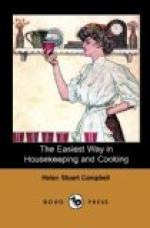Take a little flour; wet it with cold water enough to form a dough. Place it on a sieve, and, while working it with one hand, pour a steady stream of water over it with another. Shortly you will find a grayish, tough, elastic lump before you, while in the pan below, when the water is carefully poured off, will be pure wheat-starch, the water itself containing all the sugar, dextrine or gum, and mineral matter. This toughness and elasticity of gluten is an important quality; for in bread-making, were it not for the gluten, the carbonic-acid gas formed by the action of yeast on dough would all escape. But, though it works its way out vigorously enough to swell up each cell, the gluten binds it fast, and enables us to have a panful of light “sponge,” where a few hours before was only a third of a pan.
Starch, as you have seen, will not dissolve in the cold water. Dry it, after the water is poured on, and minute grains remain. Look at these grains under a microscope, and each one is cased in a thick skin, which cold water can not dissolve. In boiling water, the skins crack, and the inside swells and becomes gummy. Long boiling is thus an essential for all starchy foods.
Bread proper is simply flour, water, and salt, mixed to a firm dough and baked. Such bread as this, Abram gave to his angelic guests, and at this day the Bedouin Arab bakes it on his heated stone. But bread, as we understand it, is always lightened by the addition of yeast or some form of baking-powder, yeast making the most wholesome as well as most palatable bread. Carbonic-acid gas is the active agent required; and yeast so acts upon the little starch-granules, which the microscope shows as forming the finest flour, that this gas is formed and evenly distributed through the whole dough. The process is slow, and in the action some of the natural sweetness of the flour is lost. In what is known as aerated bread, the gas made was forced directly into the dough, by means of a machine invented for the purpose; and a very scientific and very good bread it is. But it demands an apparatus not to be had save at great expense, and the older fashions give a sufficiently sweet and desirable bread.
Rye and Indian Corn form the next best-known varieties of flour in bread-making; but barley and oats are also used, and beans, pease, rice, chestnuts, in short, any farinaceous seed, or legume rich in starch, can fill the office.




